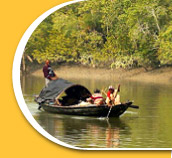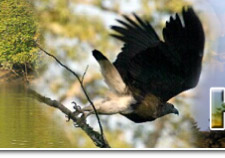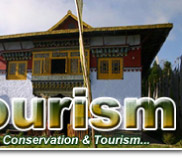The river Manas springs in the mountains of Bhutan and crosses the lowlands of Assam to mouth into mighty Brahmaputra. The landscape is a mixture of dense rainforests and grasslands criss-crossed by several smaller rivers. With Royal Manas Nationalpark on the Bhutanese side Manas forms one of the largest uninterrupted Protected Areas of the subcontinent.
The climate in Manas is characterized by warm summers and cool winters with temperatures ranging from 5°C in winter to 37°C during summer. Best time to visit is October until mid-March during the dry season. During the Monsoon season, mid-May to September, flooding is a common sight in the western half of the Reserve, the Eastern range is less affected.
To protect the rich diversity of Manas, the area has been declared a Wildlife Sanctuary and a Nationalpark, it is both a Project Tiger, Elephant and Rhino Reserve, and since 1985 it is inscribed in the List of the World Heritage. The Protected Area supports 22 scheduled species, and, according to World Conservation Monitoring Center, it is the richest in species of all Indian wildlife areas. In 1992, UNESCO took the dramatic step to include Manas in the List of Heritage Sites in Danger, after it had witnessed heavy damage during the times of the Bodo Independence Movement.
The Manas Maozigendri Jungle camp is a small setup with four cottages and a dining cum commons area in ethnic style architecture. In the near-by village two guesthouses can accommodate 20 guests and for those who prefer immediate insight into a Bodo household homestay facilities are available.
The project currently engages a pool of 31 local people as staff (service, housekeeping, gardening, and maintenance) and guides. Whenever tourists visit, the members of this staff pool independently manage their schedule according to their vacancy. This extended staff pool is an excellent model to guarantee best service quality to the customers 24/7.
The local cuisine uses rice and fresh vegetables. Pork, chicken and fish are common, as the Bodos traditionally are non-vegetarians. The favorite drink of the Bodos is a rice-wine named 'Zu Mai'.
The Bodo culture is a rich blend of colors, sounds and dances. The growing of silkworms is common and from young age on girls are educated in the weaving of the colorful cloths that later become 'dokhnas' and shawls, the traditional custome.
Almost every household owns a loom and handing over a shawl or a dhokna to a visitor is an honor. Moreover, the Bodo are expert craftmen in Bamboo.
Along with the Camp various self-help groups like handloom and cultural music and dance groups have been initiated.
The conservation volunteers of the Manas-Maozigendri Ecotourism Society (MMES) daily go out for patrolling in the Nationalpark and since poaching activities and the extraction of timber have decreased significantly. The entry points to the Nationalpark are permanently guarded, and park management activities like controlled burning of grassland habitats are carried out.
Besides the local Bodo people, many affiliated with the Manas-Maozigendri Ecotourism Society, the field director's office of Manas Tiger reserve, the Bodoland Territory Council, other Conservation NGOs, and few stakeholders from the travel trade are cooperation partners of the project.
If you are interested in experiencing Manas, please click here.
For more information about the Social Development and Conservation Programmes click here.
UNEP World Conservation Monitoring Center provides a detailed description about the ecosystem.
Top |



